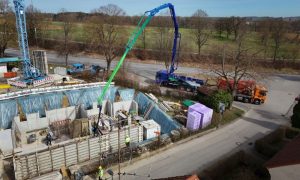Delivering Saudi’s transformation
Saudi Arabia’s ‘blue sky’ vision hasn’t been without significant challenges – but we’re now seeing positive signs of a construction market shift. Tim Whealy, Partner, HKA, outlines the key steps that will help ensure best stakeholder outcomes

As Saudi Arabia constructs a new economy, there’s no doubt that the country must reconfigure its construction and engineering market in order to deliver the extraordinary pipeline of major projects. Do we see signs of this essential transformation taking place? The answer is a categoric ‘yes’ – and, as evidence for this positive assessment, consider the significant legal reforms that have been enacted; the growing desire to embrace technology; a drive for sustainability; and the steady shift towards more equitable contractual agreements.
We’ve seen massive changes in the Kingdom during the past 13 years, and a marked shift over the last five. There has been recognition at the highest levels that radical change is essential if Vision 2030 and other major developments are to be delivered.
In reality, only Europe’s post-war reconstruction or China’s modernisation bear comparison to the scale of the Saudi plans. The timeline is also daunting. As well as delivering what must be the world’s largest transformation programme, there are the event-driven deadlines of the 2029 Asian Winter Games, 2030 World Expo and 2034 World Cup. Associated infrastructure, stadia and facilities must be built alongside giga-project cities still in their embryonic stages.
As Tim Whealey, Partner, HKA, comments: “The Kingdom has consistently strived for reform as it continues to implement its strategy to diversify from a hydrocarbon-based economy. What is truly impressive is not only the extent and scale of these reforms, but the pace at which the changes have been implemented and the way Kingdom has embraced deep change. All this highlights the Kingdom’s ambition and underlines the priority it places on the delivery of Vision 2030 (and the wholesale transformation of the Kingdom). Three notable reforms are:
- The sweeping changes to the legal system (through the introduction of the Civil Transaction Law)
- The creation of the SCCA to ensure that world-class ADR services are available in-Kingdom
- The use of project procurement routes that actively seek to de-risk the project delivery process and capitalise on Contractors’ skills from a much earlier stage of a project.
“These, and the myriad other changes, have created a strong foundation for the ongoing roll-out of what must be the world’s largest transformation project; and they explicitly demonstrate the Kingdom’s commitment to its Vision.”
Learning the lessons
Avoiding past conflicts and overruns will be crucial. Last year, HKA’s Sixth Annual CRUX Insight Report analysed more than 1,800 projects in 106 countries with a combined CAPEX of $2.247 trillion. CRUX showed that overruns in the Middle East were among the longest of the world’s regions, averaging 82% of planned schedules (and nearly 100% in Saudi Arabia). On average, the costs claimed on these 401 projects exceeded 35% of agreed budgets.
The most dominant causes of project claims and disputes were change in scope (54%), and the often-related problems of design information being issued late (34.9%) or incomplete (30.5%). Conflicts over contract interpretation (28.8%) and late approvals (27.1%) completed the other ‘top five’ causes.
What about in Saudi Arabia itself? Well, in the Kingdom, scope change (54%) and late designs (34.5%) again came top, with restricted or late access to sites (also 34.5%), followed by late approvals (31.9%) and cashflow and payment issues (23.6%).
Re-balancing risk
While the risks of delay and cost overruns mount over the project lifecycle, the opportunities to minimise those risks are greatest in pre-construction – during inception, design and procurement. Risk allocation needs to be realistic and reasonable. In a super-heated market, there is a re-balancing of power and contractors are in a more equitable position. They can push back on onerous terms. So, we are beginning to see a more sensible view of risk sharing and changes in the way that employers and contractors are procuring, such as collaborative contracting and public-private partnerships (PPPs).
But changes in the market need to go further. There must be a push on ‘planning to succeed’, rather than simply repeating past mistakes. As well as ECI, this new delivery model should, for example, involve open-book accounting and incentivising target costs and key outcomes – with sharing of gains and pain alike. High performance must be encouraged and rewarded; it’s fundamental to achieving what’s most important to the client; and so is the shift towards ensuring that any claims are resolved before developing. A new, enlightened approach of this kind would, surely, be of benefit to all parties.
Reforming the law
There are other positive trends, too, such as a greater investment in off-site prefabrication and a noticeably increasing commitment to ESG (environment, social and governance).
Notwithstanding, factors such as adversarial contracts, an opaque legal system and heavy losses sustained on past projects have made many contractors reluctant to enter the market. We see initiatives to rectify this in the new Civil Transaction Law, which promises fair dealings in contracts, while the Saudi Centre for Commercial Arbitration (SCCA) is a truly credible forum for administering international disputes. These are massive changes that can build confidence among foreign contractors.
There is still one harsh reality: given that the construction market is still in the early stages of transition, the ongoing capacity, supply chain and cost escalation risks will be colossal. But the opportunities created by Saudi Arabia’s epoch-making vision are hugely exciting – contributing to a national transformation that will embrace every sector from construction and power to transportation, tourism and housing.














